|
IMPORTANT
|
|
Note the following points when using the multi-purpose tray:
Paper Quantity: One to approximately 100 sheets (21 lb bond (80 g/m2), stack approximately 3/8" (10 mm) high)
Paper which has been rolled or curled must be straightened out prior to use, to allow the paper to feed smoothly through the multi-purpose tray (allowable curl amount: less than 3/8" (10 mm) for normal paper, less than 1/5" (5 mm) for heavy paper). There are some types of paper stock, which may meet the above specifications, but cannot be fed into the multi-purpose tray.
For information on paper that can be loaded, see "Available Paper Stock."
Make sure that you fan the sheets of paper well before placing them. Thin paper, recycled paper, pre-punched paper, heavy paper, labels, and transparencies should be fanned particularly well before loading it.
Do not load different size/type paper at the same time.
Be sure to correctly set the paper type. When printing on special types of paper, such as heavy paper or transparencies, be sure to correctly set the paper type, especially if you are using heavy paper. If the type of paper is not set correctly, it could adversely affect the quality of the image. Moreover, the fixing unit may become dirty and require a service repair, or the paper could jam.
|
|
NOTE
|
|
For high-quality printouts, use paper recommended by Canon.
|
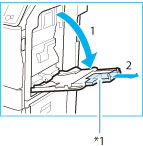
|
NOTE
|
|
If the paper size you are going to load into the multi-purpose tray is different from the paper size stored in [Register Multi-Purpose Tray Defaults] in [Preferences] (Settings/Registration), set [Register Multi-Purpose Tray Defaults] to 'Off'. (See "Registering Multi-Purpose Tray Default Settings.")
|
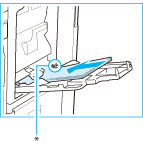
 ).
).|
IMPORTANT
|
|
When loading paper into the multi-purpose tray, align the paper stack neatly between the slide guides. If the paper is not loaded correctly, a paper jam may occur.
When loading paper into the multi-purpose tray, align the paper stack evenly between the slide guides. The paper may not be fed if the slide guides are set to a position narrower than the paper, causing the paper to curl.
|
|
NOTE
|
|
If there are instructions on the paper package about which side of the paper to load, follow those instructions.
When the paper is loaded into the multi-purpose tray, the side facing down is the one printed on.
If problems, such as poor print quality or paper jams occur, try turning the paper stack over and reload it.
For more information on the print direction of preprinted paper (paper which has logos or patterns already printed on it), see "Relationship Between the Original Orientation and Paper Orientation."
If the paper is curled when using the multi-purpose tray, a paper jam may occur. Therefore, fix the curling as indicated in the diagram before loading the paper into the multi-purpose tray.
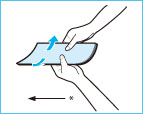 * Feeding Direction
To copy or print on the backside of preprinted paper by using the multi-purpose tray, fix the curling and then load the preprinted paper with the printed side face up. If you want to perform 2-Sided printing, set paper as shown in the illustration below in order to print with the same orientation of the preprinted side.
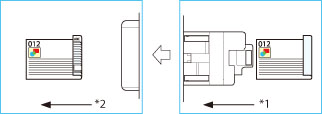 *1 Feeding Direction
*2 Output Direction
|
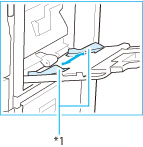
|
IMPORTANT
|
|
Set the paper size to the same size as the paper loaded in the multi-purpose tray. Selecting paper or envelopes of a different size may cause a paper jam.
|
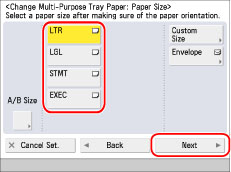
|
NOTE
|
|
To select an A or B series paper size, press [A/B Size].
|
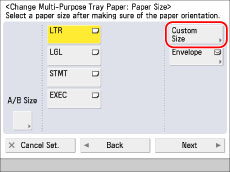
|
NOTE
|
|
If you make a mistake when entering values, press
 (Clear) → enter the correct values. (Clear) → enter the correct values.To select a registered paper size stored in a size button ([S1] to [S4]), you must store the irregular paper size in the size button beforehand. For instructions on storing irregular paper sizes, see "Registering/Editing/Deleting Custom Paper Sizes."
|
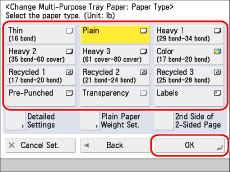
|
NOTE
|
|
Transparencies can be selected only if you select LTR as the paper size.
For more information on paper types, see "Available Paper Stock."
You can register paper types that are not listed in Detailed Settings for Selecting the Paper Type. For information on registering a custom paper type, see "Registering/Editing Custom Paper Types."
|
|
IMPORTANT
|
|
Depending on the type of heavy paper you want to load, if you load multiple sheets of heavy paper into the multi-purpose tray, a paper jam may occur. In this case, load only one sheet of heavy paper at a time.
If you are making two-sided prints, select the 2-Sided mode. The printed-paper may crease depending on the moisture absorption condition of the paper.
|